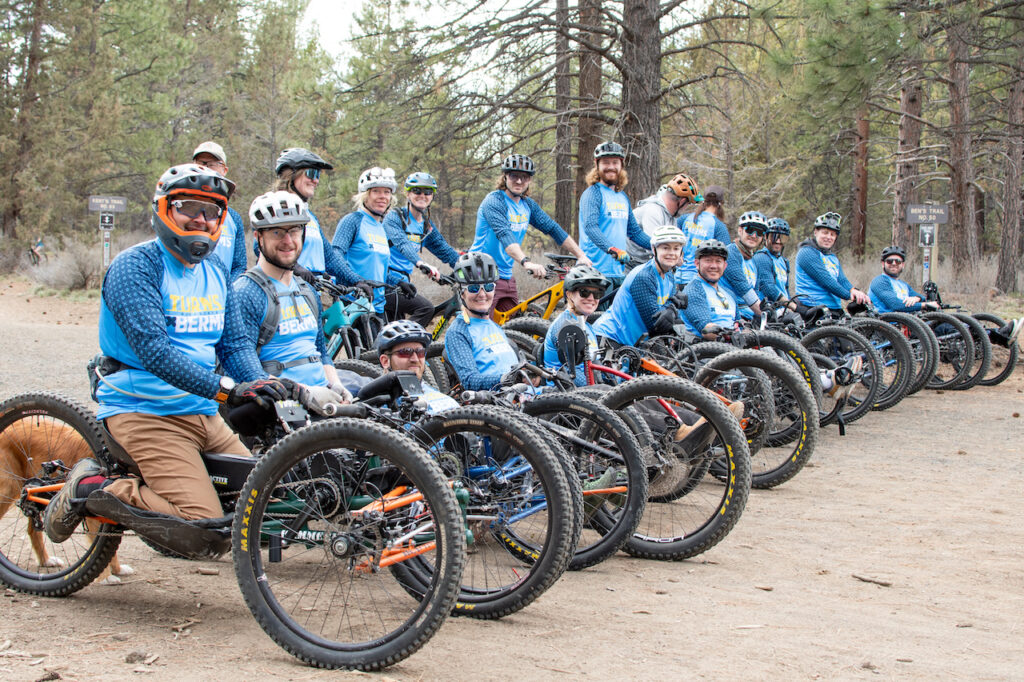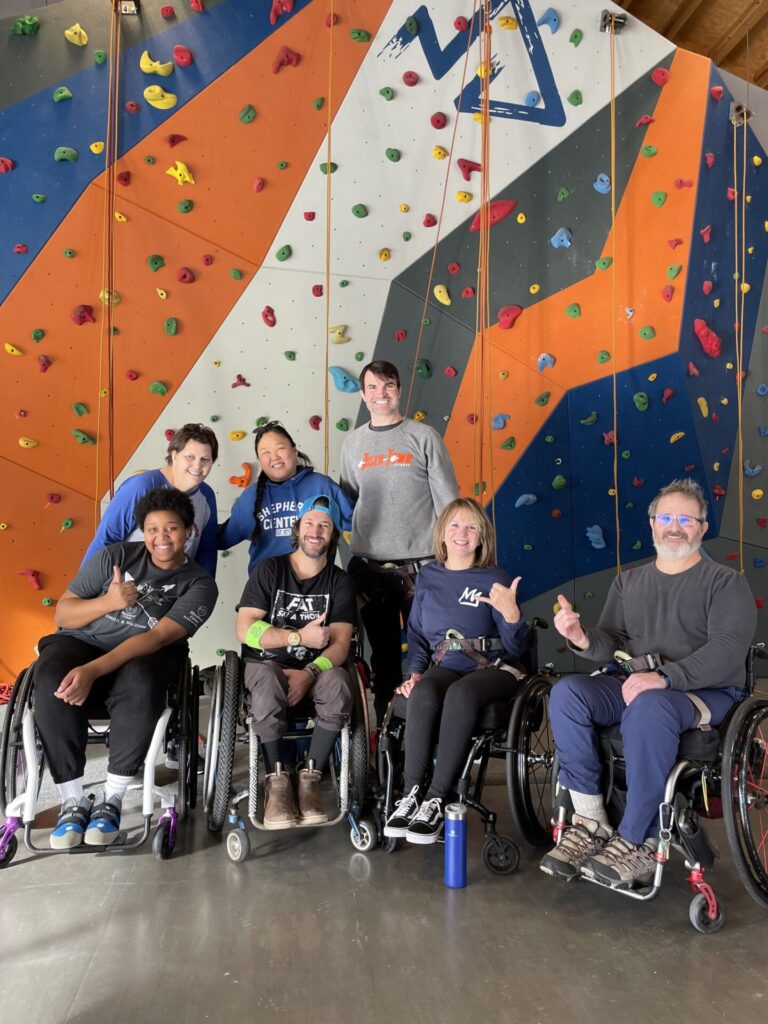Bike to Work: Making Greener Commuting Accessible
May 20, 2022 is National Bike to Work Day, part of the League of American Cyclists Bike Month. On this day, Americans are encouraged to ditch their cars and hop on their bike for their commute into the office.
At KBF HQ, we’re on our bikes any chance we get and a number of our staffers are lucky to be able to include bike commuting as a regular part of their routines. The benefits of bike commuting–to the local economy and ecology as well as to the biker’s physical and mental health and productivity– are well worth the challenges even able-bodied cyclists face. We’ve been considering some of the unique challenges that wheelchair users face as they strive to be greener, healthier commuters.
BENEFITS OF BIKE COMMUTING
There is a wealth of data available that supports the benefits of commuting by bike. A few high notes:
- Cycling improves cardiovascular and aerobic fitness, lowers blood pressure, boosts energy, builds muscle and improves coordination.
- Bikers avoid the downsides of car-commuting: sitting in traffic; navigating a congested city; riding on crowded public transit—all of which can get your day off to a bad start.
- Biking to work saves money in fuel costs, wear and tear on your car, and parking.
- On a bike, the only Co2 emissions are released by the cyclist through respiration, amounting to about .7 grams per mile—as compared to the average American vehicle which releases about 1.2 pounds of Co2 per mile.
- Local economies benefit greatly from bike commuters, who tend to run their errands in locally-owned shops rather than the national chains located outside of downtown cores.
BIKE COMMUTING FOR WHEELCHAIR USERS
These are universal benefits, regardless of whether a commuter is able-bodied or a wheelchair user. But for wheelchair users, additional complexities can can make bike commuting feel impossible. So we started wondering: What are the barriers wheelchair users face that make bike commuting difficult? What are ways they have overcome these challenges to enjoy these benefits?
To start, there is the simple truth that for able-bodied cyclists, their primary mode of transportation is walking. A bike makes mobility faster and allows the rider to travel greater distances at a faster speed, but they can easily transition back to their primary mode of transportation.
For a wheelchair user, once they get in their handcycle, they are without their primary mode of transportation. A wheelchair user needs to have their wheelchair. So the idea that a commuter would toss their lunch, laptop, and a change of clothes in their backpack, hop on their bike and pedal to work becomes immediately more challenging for a wheelchair user who has to ask—how do I bring my chair? How do I transfer independently from my chair to my handcycle, hitch my chair to whatever transportation device that makes it possible to transport the chair, and then reverse the process upon arrival to work?
There’s also the question of storage: most bike racks or even bike rooms will not accommodate a handcycle, and these pieces of equipment are too expensive to leave out on the street during the day and risk theft or damage.
Add the challenge of safety in commuting—especially as handcycles have gotten lower to the ground. Limited visibility makes riding in higher traffic areas incredibly dangerous.
And finally, there is a very real difference in physical exertion for handcycling vs. biking. Your commute is not the ideal time to be getting intense exercise, unless you are able to easily change your clothes upon arrival at the office. A quick change from commuting attire to the professional attire you need in the office is relatively simple for an able-bodied commuter; for many wheelchair users this creates an additional awkward challenge.
None of this is insurmountable, nor does it negate the benefits of bike commuting listed above. For wheelchair users some additional thought is required to make car-free commuting possible.
RIDE WITH A BUDDY
If you have a roommate, family member, friend, or colleague who can help with transfers and serve as a set of eyes on the road, riding into work together is a great solution.
This still requires transporting the chair, which can be accomplished with the use of a trailer like the Wheelchair Towbar designed by Top End, and storing your handcycle upon arrival to the workplace, assuming your work environment has a safe and secure place to do so. Additionally, it’s worth noting that by and large commuting is an independent activity. Most people won’t easily be able to find a buddy to commute with.
EXPLORE ALTERNATIVES TO HANDCYCLES
It became pretty clear pretty quickly that a handcycle is not an ideal commuting vehicle. So we began exploring devices that are designed to adapt hand-powered wheelchairs to make them more suitable for commuting. The options are limited, and there is not currently an “off the shelf” device that will work for all wheelchair users.
For adaptive cyclists, customizations and options for equipment are limited–especially when compared to those available to their able-bodied peers, but the needs for customization are just as great. As time passes we know we’ll see an increase in equipment tailored to adaptive athletes with different levels of injury and varied specialized needs. In the meantime, the more people who are using the equipment currently available and identifying what works and what needs to be improved, the faster solutions will come to accommodate more adaptive athletes.
WHEELCHAIR ATTACHMENTS
Adaptive devices do exist to transform an existing wheelchair into an electric scooter, manual handcycle, or e-assist handcycle. Rio Mobility’s line of wheelchair attachments do exactly that; making it possible to clip into a scooter attachment that transforms the user’s day-to-day chair so that it is more suitable for traveling greater distances at higher speeds. These attachments are secure, and after initial installation very easy to use independently. They carry a price tag upwards of $1,000 and are a bit bulky so storage can be a challenge, but compared to a traditional handcycle both in cost and logistics, they are an incredible option for wheelchair users looking to ditch their cars for their commutes.
MODIFIED EQUIPMENT
Some wheelchair users, like KBF friend Erik Kondo, have adapted other existing devices to enhance the commuting capabilities of their wheelchairs. One solution he’s employed is a folding e-scooter that he can roll onto. Using this scooter he can easily roll the 3-4 miles on the bike path near his house to the metro, then fold the scooter and place it in his lap for the train ride into Boston.
This scooter runs a couple hundred dollars, so if it is damaged in transit, or stolen from storage (though he can bring it right to his desk) the cost to replace it is not as prohibitive as a “true” scooter attachment. Our own Greg Durso has a similar modified e-scooter that he uses to get into the office and around Burlington. Of course not every chair user will be comfortable on modified equipment, but innovations like these help to imagine what could be possible on a larger scale.
IMAGINATION AND INSPIRATION
If there’s one thing we know about the KBF community it’s that they have no shortage of ideas on how to adapt and overcome the obstacles that stand between them and their desired lifestyle.
Perhaps the simplest solution is to consider how to transform an existing manual wheelchair into a commuting device–Erik envisions a small motor that could act as a commuter-specific e-assist; providing a “boost” for wheelchair users that would increase their speed from 3-4 mph to 8-10 mph without adding much weight to their chair.
But we want to know what you think? What is the path forward to make independent car-free commuting a reality for more wheelchair users? Hop over to our instagram and join the conversation there; we can’t wait to hear what people think!



